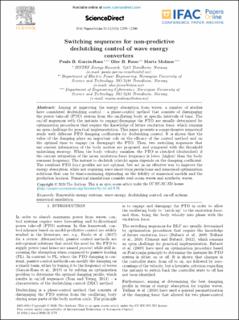| dc.contributor.author | Garcia Rosa, Paula Bastos | |
| dc.contributor.author | Fosso, Olav B | |
| dc.contributor.author | Molinas Cabrera, Maria Marta | |
| dc.date.accessioned | 2021-05-25T07:40:14Z | |
| dc.date.available | 2021-05-25T07:40:14Z | |
| dc.date.created | 2021-05-18T13:11:31Z | |
| dc.date.issued | 2021 | |
| dc.identifier.citation | IFAC-PapersOnLine. 2021, 53 (2), 12295-12300. | en_US |
| dc.identifier.issn | 2405-8963 | |
| dc.identifier.uri | https://hdl.handle.net/11250/2756161 | |
| dc.description.abstract | Aiming at improving the energy absorption from waves, a number of studies have considered declutching control - a phase-control method that consists of disengaging the power take-off (PTO) system from the oscillating body at specific intervals of time. The on/off sequences with the instants to engage/disengage the PTO are usually determined by optimization procedures that require the knowledge of future excitation force, which remains an open challenge for practical implementation. This paper presents a comprehensive numerical study with different PTO damping coefficients for declutching control. It is shown that the value of the damping plays an important role on the efficacy of the control method and on the optimal time to engage (or disengage) the PTO. Then, two switching sequences that use current information of the body motion are proposed, and compared with the threshold unlatching strategy. When the body velocity vanishes, the PTO is clutched (declutched) if the current estimation of the mean excitation force frequency is lower (higher) than the body resonant frequency. The instant to declutch (clutch) again depends on the damping coefficient. The resultant PTO force profiles are not optimal, but act in an effective way to improve the energy absorption, while not requiring wave short-term predictions and numerical optimization solutions that can be time-consuming depending on the fidelity of numerical models and the prediction horizon. Numerical simulations consider real ocean waves and synthetic waves. Copyright © 2020 The Authors. This is an open access article under the CC BY-NC-ND license | en_US |
| dc.language.iso | eng | en_US |
| dc.publisher | Elsevier | en_US |
| dc.rights | Attribution-NonCommercial-NoDerivatives 4.0 Internasjonal | * |
| dc.rights.uri | http://creativecommons.org/licenses/by-nc-nd/4.0/deed.no | * |
| dc.title | Switching sequences for non-predictive declutching control of wave energy converters | en_US |
| dc.type | Peer reviewed | en_US |
| dc.type | Journal article | en_US |
| dc.description.version | publishedVersion | en_US |
| dc.source.pagenumber | 12295-12300 | en_US |
| dc.source.volume | 53 | en_US |
| dc.source.journal | IFAC-PapersOnLine | en_US |
| dc.source.issue | 2 | en_US |
| dc.identifier.doi | 10.1016/j.ifacol.2020.12.1172 | |
| dc.identifier.cristin | 1910511 | |
| dc.description.localcode | © 2020 The Authors. This is an open access article under the CC BY-NC-ND license. | en_US |
| cristin.ispublished | true | |
| cristin.fulltext | original | |
| cristin.qualitycode | 1 | |

